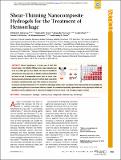| dc.contributor.author | Assmann, Alexander | |
| dc.contributor.author | Paul, Arghya | |
| dc.contributor.author | Khademhosseini, Ali | |
| dc.contributor.author | Avery, Reginald Keith | |
| dc.contributor.author | Gaharwar, Akhilesh | |
| dc.contributor.author | McKinley, Gareth H | |
| dc.contributor.author | Olsen, Bradley D | |
| dc.date.accessioned | 2015-09-16T16:24:40Z | |
| dc.date.available | 2015-09-16T16:24:40Z | |
| dc.date.issued | 2014-09 | |
| dc.date.submitted | 2014-07 | |
| dc.identifier.issn | 1936-0851 | |
| dc.identifier.issn | 1936-086X | |
| dc.identifier.uri | http://hdl.handle.net/1721.1/98531 | |
| dc.description.abstract | Internal hemorrhaging is a leading cause of death after traumatic injury on the battlefield. Although several surgical approaches such as the use of fibrin glue and tissue adhesive have been commercialized to achieve hemostasis, these approaches are difficult to employ on the battlefield and cannot be used for incompressible wounds. Here, we present shear-thinning nanocomposite hydrogels composed of synthetic silicate nanoplatelets and gelatin as injectable hemostatic agents. These materials are demonstrated to decrease in vitro blood clotting times by 77%, and to form stable clot-gel systems. In vivo tests indicated that the nanocomposites are biocompatible and capable of promoting hemostasis in an otherwise lethal liver laceration. The combination of injectability, rapid mechanical recovery, physiological stability, and the ability to promote coagulation result in a hemostat for treating incompressible wounds in out-of-hospital, emergency conditions. | en_US |
| dc.description.sponsorship | United States. Army Research Office (Contract W911NF-13-D-0001) | en_US |
| dc.description.sponsorship | National Institutes of Health (U.S.) (Interdepartmental Biotechnology Training Program NIH/NIGMS 5T32GM008334) | en_US |
| dc.language.iso | en_US | |
| dc.publisher | American Chemical Society (ACS) | en_US |
| dc.relation.isversionof | http://dx.doi.org/10.1021/nn503719n | en_US |
| dc.rights | Article is made available in accordance with the publisher's policy and may be subject to US copyright law. Please refer to the publisher's site for terms of use. | en_US |
| dc.source | ACS | en_US |
| dc.title | Shear-Thinning Nanocomposite Hydrogels for the Treatment of Hemorrhage | en_US |
| dc.type | Article | en_US |
| dc.identifier.citation | Gaharwar, Akhilesh K., Reginald K. Avery, Alexander Assmann, Arghya Paul, Gareth H. McKinley, Ali Khademhosseini, and Bradley D. Olsen. “Shear-Thinning Nanocomposite Hydrogels for the Treatment of Hemorrhage.” ACS Nano 8, no. 10 (October 28, 2014): 9833–42. © 2014 American Chemical Society | en_US |
| dc.contributor.department | Harvard University--MIT Division of Health Sciences and Technology | en_US |
| dc.contributor.department | Massachusetts Institute of Technology. Department of Biological Engineering | en_US |
| dc.contributor.department | Massachusetts Institute of Technology. Department of Chemical Engineering | en_US |
| dc.contributor.department | Massachusetts Institute of Technology. Department of Mechanical Engineering | en_US |
| dc.contributor.department | Koch Institute for Integrative Cancer Research at MIT | en_US |
| dc.contributor.mitauthor | Gaharwar, Akhilesh K. | en_US |
| dc.contributor.mitauthor | Avery, Reginald Keith | en_US |
| dc.contributor.mitauthor | McKinley, Gareth H. | en_US |
| dc.contributor.mitauthor | Khademhosseini, Ali | en_US |
| dc.contributor.mitauthor | Olsen, Bradley D. | en_US |
| dc.relation.journal | ACS Nano | en_US |
| dc.eprint.version | Final published version | en_US |
| dc.type.uri | http://purl.org/eprint/type/JournalArticle | en_US |
| eprint.status | http://purl.org/eprint/status/PeerReviewed | en_US |
| dspace.orderedauthors | Gaharwar, Akhilesh K.; Avery, Reginald K.; Assmann, Alexander; Paul, Arghya; McKinley, Gareth H.; Khademhosseini, Ali; Olsen, Bradley D. | en_US |
| dc.identifier.orcid | https://orcid.org/0000-0002-7272-7140 | |
| dc.identifier.orcid | https://orcid.org/0000-0002-0193-7378 | |
| dc.identifier.orcid | https://orcid.org/0000-0001-8323-2779 | |
| dc.identifier.orcid | https://orcid.org/0000-0002-0284-0201 | |
| mit.license | PUBLISHER_POLICY | en_US |
| mit.metadata.status | Complete | |
